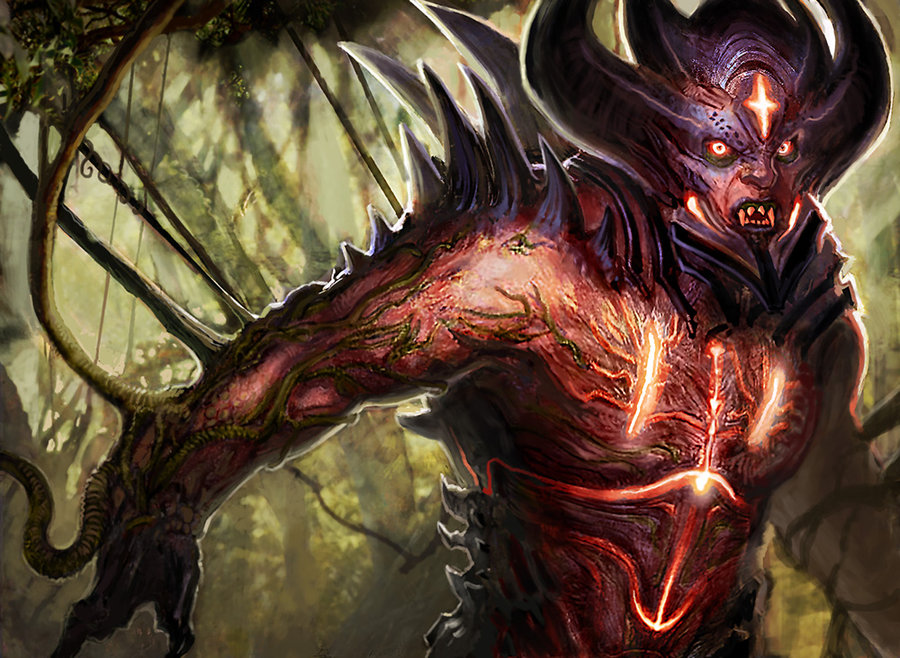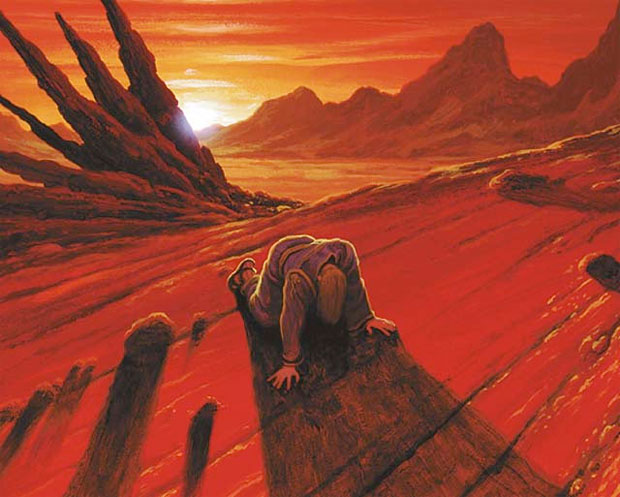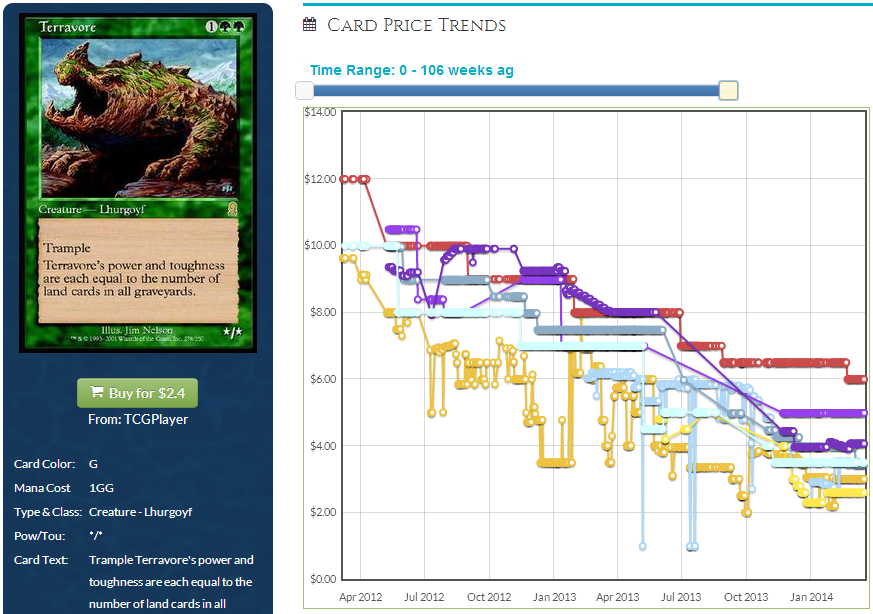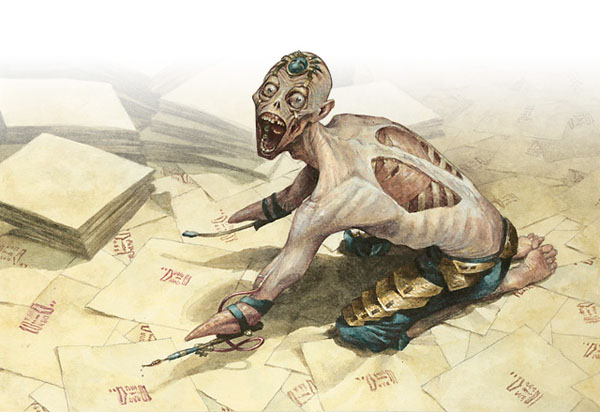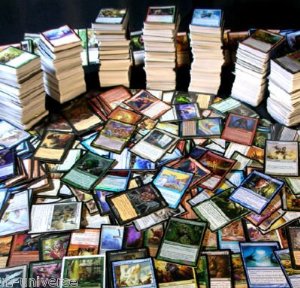Today we’re rerunning a popular article from last year all about flipping collections. Tune in on Wednesday for a full recap of GP Richmond!
By Travis Allen
A week or two ago I asked on Twitter if people wanted to hear about flipping collections, and the answer was a resounding “yes.” Today I’ll talk about some of the larger collections I’ve purchased, and then discuss some strategies to keep in mind if you choose to do it yourself.
Collection #1 – This remains the largest collection by volume and retail that I’ve purchased so far. I had picked up a few small collections for between $50 and $300 before this, but this purchase dwarfed those. This list is hardly exhaustive, but it had, if memory serves me: two beta dual lands, ~25 revised duals, a nearly-complete set of Legends, a partial set of Antiquities including a Candelabra of Tawnos, about 10 or 11 full sets including Urza’s block, a full set of Zendikar fetchlands, a handful of Onslaught fetchlands, and boxes and binders alike that were filled with random cards from Beta to Zendikar, which by volume were mostly garbage but certainly had plenty of good cardboard scattered throughout. It took the better part of two weekends to pull everything of value out, and another two or three months to break even on the sales process.
Retail value: ~$13,000
I paid: $3,500
Collection #2 – While this wasn’t as many cards as collection #1, nor was it as varied in its inventory, it was solid value throughout. I actually ended up paying more for this than I did #1, even though it was technically worth less. (They can’t always be home runs.) This seller had done his homework, and actually sent a list of basically every single rare in the collection with their average eBay prices. The reason I paid more for less on this collection is simply that the seller was far more educated about what he had. He recognized he wouldn’t be getting full retail, but expected a reasonable rate of return. Included were: 33 Revised duals, 31 Zendikar fetches, 22 Onslaught fetches, 4 FoW, 4 Thoughtseize, 4 Cryptic Command, 2 JTMS, 5 SFM…the list just goes on with hundreds of $3-$50 cards.
Retail value: ~$9,500
I paid: $5,000
Collection #3 – This is the smallest “large” collection I’ve bought. Unlike the previous two, this is a player that had gotten out of the game recently, so there was a good chunk of Standard cards. In this case, he had everything listed through DeckBox, so I was able to see a complete list of what was coming, as well as their TCG values. He obviously had that information as well, so it was mostly a matter of finding a number that we both agreed on. The most valuable card here was a single Unlimited Underground Sea. Beyond that, there wasn’t anything particularly stellar, just Good Cards. 6 Onslaught fetches, a Taiga, a set of Liliana of the Veil, a few Eldrazi, some Kiki-Jiki, Sphinx’s Revelations, Bonfires, Cavern of Souls, etc.
Retail Value: ~$4,900 TCG Player low
I paid: $2,200
Now that you’re tired of reading about what I’ve done, let’s talk about how to do it yourself.
Where to find collections – There are essentially two types of sellers. The first, and typically most lucrative, is the obvious one: craigslist. I have a tab open to a craigslist search for “Magic” that is always there when I turn on my computer, and I keep an eye on it every day. There is going to be a lot of chaff on craigslist, so patience is required. There was over a year between my purchases of collection #1 and #2. They simply don’t show up that often, and as time progresses, we are going to see it less and less as those stockpiled Magic cards end up in the hands of people like you and I, who then hoard and distribute cards amongst the community. You will, however, see plenty of this:
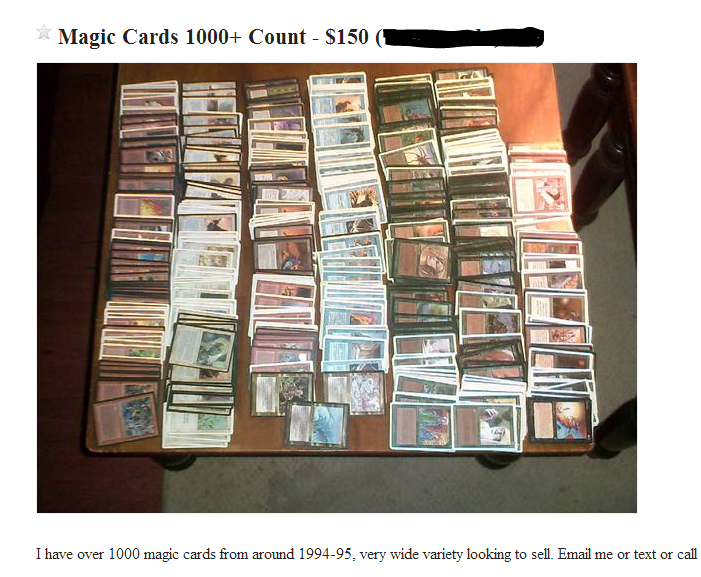
For the low price of $150, you can have over 1,000 garbage Ice Age, Homelands and Revised commons. Craigslist is really just going to come down to being patient and finding the right lot.
Other options are garage/estate sales, which I’ve found to be pretty unreliable. Typically you’re talking shoeboxes in size. Keep an eye out for these when you’re strolling yard sales with your girlfriend, but don’t expect it to be reliable.
Coworkers/muggle peers are also a potential source. You really want to find people that are about 40-45 years old right now, as that would have made them 20-25 when Alpha came out, which is the perfect age for disposable income on nerd crap like this. You might not want to be asking your three-piece suit boss if they have Magic cards, but I’ll leave the discovery process here up to your discretion.
The second seller is the knowledgeable type. These are people that have been playing somewhat recently, and have decided to get out of the game for whatever reason. They are much better at accurately valuing their collection, so you won’t be getting duals for $5 apiece here. It doesn’t mean you can’t get a good rate, it just means that there is going to be a lot less of a game where you try and feel out the seller’s knowledge and expectations. In my experience, these transactions are faster, more straightforward, and more numbers-oriented. Both of you know the score, and you’re just trying to find a price you’re both comfortable with.
How to Evaluate Inventory – You can typically get a good feel for what is in the collection quickly, so long as it isn’t completely massive. I like to start with the binders, as those are where you’re most likely to find concentrated value. I also like to check out any decks they may have built, and if the boxes of cards are sorted at all, I at least try to look at lands, artifacts, and blue spells. If it’s sorted by set, I’ll look for Urza block, Mirage, any Legends/Antiquities, Mirrodin block, Future Sight block, etc. Be prepared for most large collections to be overwhelmingly Revised/Ice Age/Homelands/Fallen Empires. When flipping through boxes, feel free to just skip over these sections entirely. You should still go through the painstaking process of looking at each card once you get the boxes home, but when deciding whether to buy the cards, don’t waste both their time and yours looking through what may as well be kindling.
On large collections (over a few thousand cards,) I’ll bring a small notepad to keep track of what I’m seeing. Once the collection is of sufficient size, you aren’t going to be able to make a reasonable offer off the top of your head, nor will you likely have that much cash in your pocket anyways. Writing down quantity of duals/fetches, a rough idea of how many >$5 cards you saw, etc. will help you remember what you’re dealing with when you get home.
Questions to ask – There are a number of questions you want to ask the seller. Their answers will help you understand what you’re looking at as well as what to expect in negotiations. It also helps to make small talk with people while you’re rifling through their property inside their house. Being personable and friendly will make them much more likely to be flexible on price. As a side note, avoid divulging too many details regarding your experience in purchasing collections. If they get the impression you’ve done this quite a bit, they may perceive you as a bit of a shyster rather than an earnest individual that just wants some Magic cards.
- “Has anyone else looked at the collection?’’ Here you’re gauging interest. They may lie, so take what they say with a grain of salt. If they tell you they’ve had 8 or 9 emails about it though, they probably aren’t exaggerating by much. It’s not uncommon for lots listed too cheaply to be sold within hours of being listed.
- “Has anyone bought any singles out of the collection?” You want to see if someone stripped the good cards and ran. If they say that yes, that someone bought just a few cards, then that is very likely where the duals and forces went.
- “When did you start playing?” Get a feel for when the collection may have started. This tells you what to look for. If it’s after 2002 for instance, you know duals are less likely. You want to hear 1993, or sometime after 1996.
- “When did you stop playing?” This will tell you the latest set you can expect to find, as well as how aware of Magic pricing they are. If they played up until Alara block, they’re going to be a lot more aware of how much the cards may be worth, while someone that quit during Torment days has had the boxes collecting dust for years and years.
- “Why did you stop playing?” This is most salient when they quit recently. If their friends left the game and interested petered out, they likely aren’t in a rush to move the cards. However if something occurred in their life and they need funds quickly, this works in your favor. Someone who really needs $2,000 for car repairs doesn’t have time to shop their collection around. Waving ducats around has a good way of getting things done.
How to decide how much to offer – There are several factors at work when considering what type of numbers to offer.
- The obvious place to start is how much you peg the collection at. I try to keep my estimate at just the cards I’ve seen. I’ve brought home one in the past where I looked at one 500 card box, saw some good stuff, and made an offer based on that box. When I got home, it turned out that almost every good card was in that single box.
- The knowledge level of the seller is important. If it’s someone clearing out their attic, chances are they’ll just be happy to have it gone and end up with enough to go buy dinner. If it’s someone like the individual in the second example above, you aren’t getting away at 10% of retail. Lowball too much, and you’ll offend them.
- Whatever price they listed at will help you understand their expectations. Whoever was selling the cards in that craigslist picture above obviously way overvalues his cards, and even if that whole picture is worth maybe $5, that’s only about 4% of his listed price. There’s no way someone is taking 10% of their listed price. If there isn’t a price listed, that’s good for you. It means they don’t know what’s fair or they’re open to offers.
- Sellers typically assign value much more evenly across the collection than is accurate. What this means is that many will assume 5,000 Ice Age cards will be worth a lot more than a shoebox full of revised duals. While this is a pain for buying large, low-value collections, it works both ways. If during examination the inventory seems like it’s mostly garbage with just a handful of notable cards, or even just a single outlier (something like a foil MM Brainstorm), tell them that it’s all a little too rich for your blood, but ask if you can buy just a few singles that you’d love to have for yourself. There’s a good chance they’ll be fine with this, and you’ll be shocked how little people assign to individual cards. Think $2 a card. I typically avoid doing this unless the collection really is just nothing but Homelands commons, and they are expecting way more than is reasonable.
- My goal when buying a collection is 30% of retail. That gives you a very comfortable profit margin for making your money back, as you could sell at 70-80% of market and still do well. 30% is fantastic though, so don’t expect this every time. I’ve gone up to about 60% on smaller buys. Your ceiling here is dictated by what exactly you’re buying. Keep in mind what types of sales you’ll be making to recoup your costs. If it’s just piles and piles of $3-5 cards, you’re going to have to put a lot of envelopes in the mail to make that back. That’s a large investment of time, risk as a seller, and shipping costs. However, if it’s basically just a playset of Onslaught fetches and odds and ends, it’s a lot easier to pay a higher percentage because you can move more money in less transactions, they’ll sell faster, and you can get way closer to retail on a Polluted Delta than you can a foil 7th ed Mana Short.
- The size of the collection also dictates what percentage you can buy at. Basically, the larger the collection, the less competition you have. If the seller wants $400 for $1,000 worth of cards, there will be plenty of people willing to make that buy. However, someone asking $4,000 for $20,000 worth of cards, while a better price overall, will generate a lot less demand. There simply are not going to be many individuals with the knowledge and capital to make a purchase like that. These very large collections are my favorite. There’s less competition, you can get a great rate, and it’s hard for anyone to turn down a few thousand dollars in cash, regardless of how much their cards are actually worth.
- When making an offer, especially via email, I typically like to outline some of things I’m taking into consideration. I may explain that a large majority of the cards they own are from a time period that saw huge print runs, and subsequently they’re not even worth the paper they’re printed on. I may note the wear of the cards if that is a factor, or perhaps point out that while they may have seen certain numbers on eBay, there’s a sizeable loss of profit on those numbers when considering eBay fees, PayPal fees, shipping, etc. Overall, people are going to be more receptive to “Here’s the number I can offer, and this is why” compared to “$600 lmk.”
- I touched on this briefly, but their need for expediency is good news for you. If it’s someone that simply decided they’re done and is in no real rush to sell, it will tough to get a great price. An individual in a situation where they need cash quick is a lot more likely to wheel and deal.
- When you’re buying someone out entirely, you sometimes get “bonus” stuff. Dice are very common, as are an assortment of deck boxes. I picked up about 40 of those giant oversized cards in a collection at one point. Old Scrye pewter life counters are easily worth over $50. This type of stuff is typically considered throw-in, but enough of it can add some real value to the deal.
What to do when you get it all home – This is easily the most fun part; the discovery process. I try not to look at every single card when I’m evaluating the collection just so that there’s an element of surprise when I get home and open it all up. The best way to approach this is to systematically go through and touch every single card so that you don’t miss anything. As you go through, pull out every single card that catches your eye and every single rare you spot. All of them. I can’t stress this enough. Nothing is worse than going through 20,000 cards, getting to the end, realizing you were pulling out cards later on that you weren’t at the start, and having to do it all again. If some of the stuff you pull out isn’t worth the effort of selling it, it’s very easy to dump it back into a card box. Once you get everything out, start by setting aside everything you want to keep for yourself. Then begin looking up prices of everything you aren’t sure is worth selling. Any commons and uncommons that aren’t worth it can go back into the boxes. Set any bulk rares aside. The reason for this is that when it eventually comes time to deal with getting rid of the leftover chaff, having all the rares separated makes it easy for you to figure out how many there are for reselling or bulking out.
Making your money back – My preferred way of accomplishing this is not eBay, but rather going through established communities. I personally use MTGS, Twitter, and another community forum. Others prefer MOTL and various other sites. If your city has a general MTG Facebook page, that’s a great resource as well.
Buylisting the cards is an option. You will definitely get better rates of return on selling directly to individuals, but it takes a hell of a lot more time than just sending a few hundred cards to whatever vendor and getting a check. This decision is personal preference. I haven’t opted for this, but I can see the appeal.
When planning to sell to individuals, I begin by alphabetizing everything I’m selling and then setting them aside in their own box. Don’t mix the cards up into your trade collection; it’s too difficult to keep track of them if you do. Once everything is in order, I like to create a Google spreadsheet document. It’s accessible from any internet connection, has editing capabilities on the fly, you can share the link as read-only to let people browse at their own leisure, and it makes for easy importing into Excel if necessary. As you sell cards, you need to be absolutely diligent in making sure the list online matches what you have on hand. Once you start getting discrepancies, you begin agreeing to sell cards to people that you don’t actually have, and that is not something you want to be doing. Building a positive reputation is hugely important, as it enables people to feel comfortable sending you several hundred dollars at a time for cards that are sight unseen. For this reason, I would recommend picking one website with reference tracking and sticking with that until you build a solid reputation.
Getting rid of the leftovers – Unless you live in Montana or one of those states where the cattle outnumbers the humans, space becomes a concern, especially once you end up with more than a few thousand spare cards. I’ve had success moving smaller batches around 2,000-5,000 cards on craigslist by being very straightforward with the lot. I put right in the listing that there are no duals/forces, and that it’s a kitchen table collection for a kitchen table price. This gets a little harder to do the larger the pile gets though, as disposable income for kitchen table magic is not very large for any one individual. As you can see, I still have yet to solve this problem entirely myself…

Whew, I had a lot more to say about this than I realized I did. If you decide to tackle this process yourself, I wish you the best of luck. Just don’t do it where I live.
